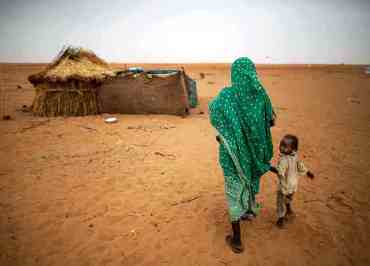Fresh violence in Darfur strains humanitarian resources
July 18, 2014 (KHARTOUM) – A fresh wave of violence across Sudan’s troubled Darfur region has placed enormous pressure on humanitarian resources, the UN Office for the Coordination of Humanitarian Affairs (OCHA) said on Tuesday.

Hostilities have spread across much of North and South Darfur, spilling over into West, Central and East Darfur.
According to OCHA, 397,057 have been displaced since the beginning of 2014, although close to 131,300 people have since returned to their areas of origin.
The figure is in addition to some 2 million people in Darfur facing long-term displacement, having fled their homes at the height of the conflict in 2003-2005.
OCHA said the majority of returnees were concentrated in the Saraf Omra (76,788) and El Lait and El Taweisha localities (52,259), with small number of people returning to their rural villages in the El Fasher locality.
In May, some 7,600 people returned to Um Gunya, Hijer and other villages in Bielel locality from Saniya Deleiba and various camps around the South Darfur capital, Nyala.
Government restrictions and ongoing insecurity initially prevented aid agencies from accessing many conflict-affected areas during the early stages of the crises.
However, over the past couple of months aid workers have been able to reach most of the affected areas and now have access to 95 per cent of the remaining 266,000 people still displaced.
“However, even though humanitarian access has opened up, the situation does remain fluid due to both the high mobility of armed forces and opposition groups and a significant increase in criminality,” it said.
Aid agencies have also been able to reach some 363,000 newly displaced people, albeit in a limited capacity.
Several areas, however, including Hashaba North, Kutum locality in North Darfur, the eastern Jebel Mara region in North, Central and South Darfur, and Adila and Abu Karinka localities in East Darfur are yet to receive humanitarian assistance.
According to OCHA, the significantly limited space for protection activities, constrained operating conditions, lack of funding and difficulties in implementing programs remain among the key concerns of the aid community in Darfur.
Competition over land and resources has added another dimension to the 11-year conflict, leading to an upsurge in inter-clan fighting between different Arab tribes in North, Central and South Darfur, according to a report released by Amnesty International earlier this year.
Darfur’s feared Rapid Support Forces (RSF) – also known as the Janjaweed militia – deployed to support government forces, have been repeatedly accused of attacking civilians and other abuses.
(ST)
